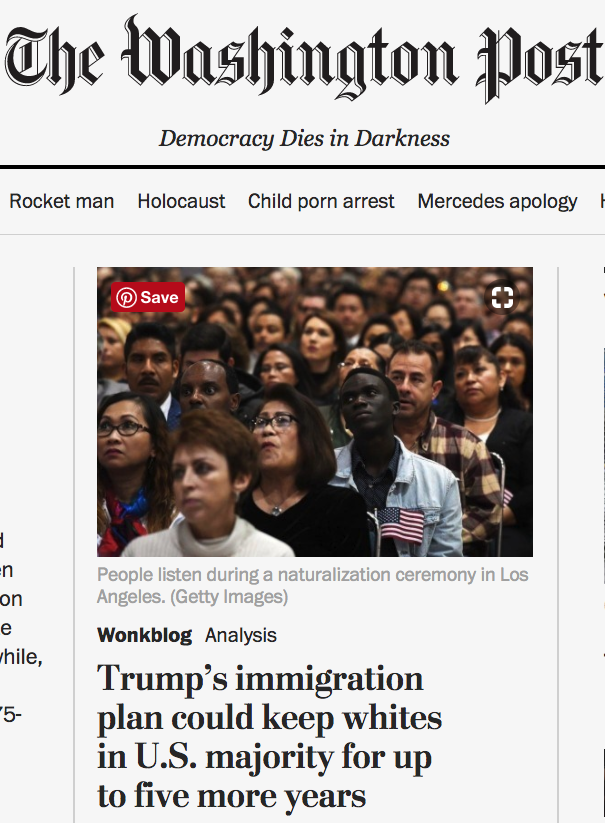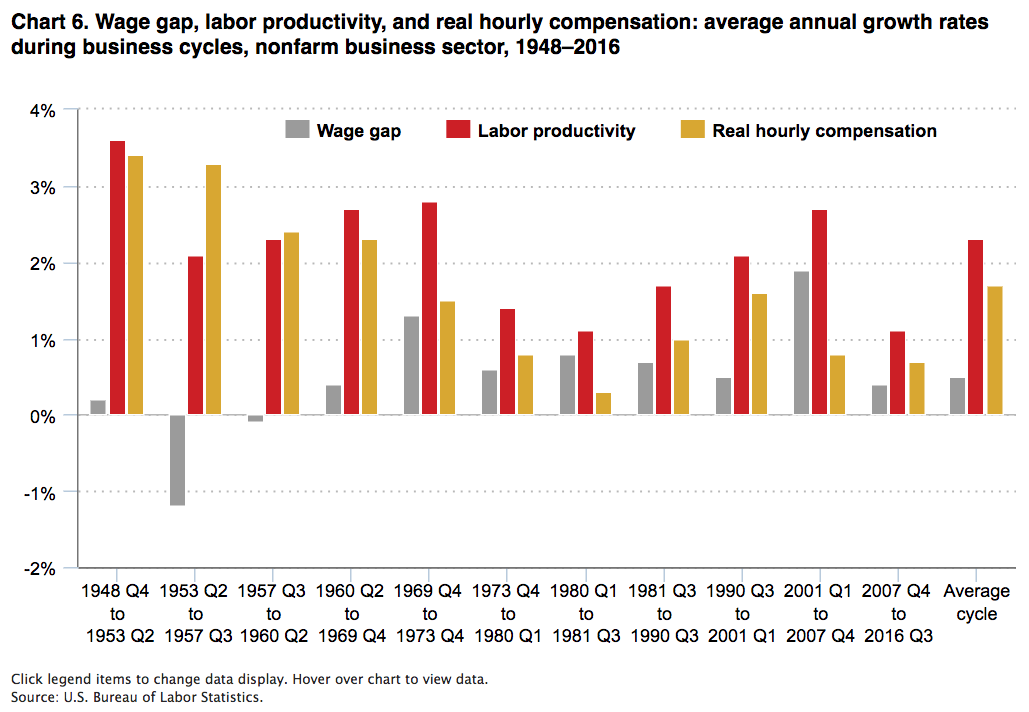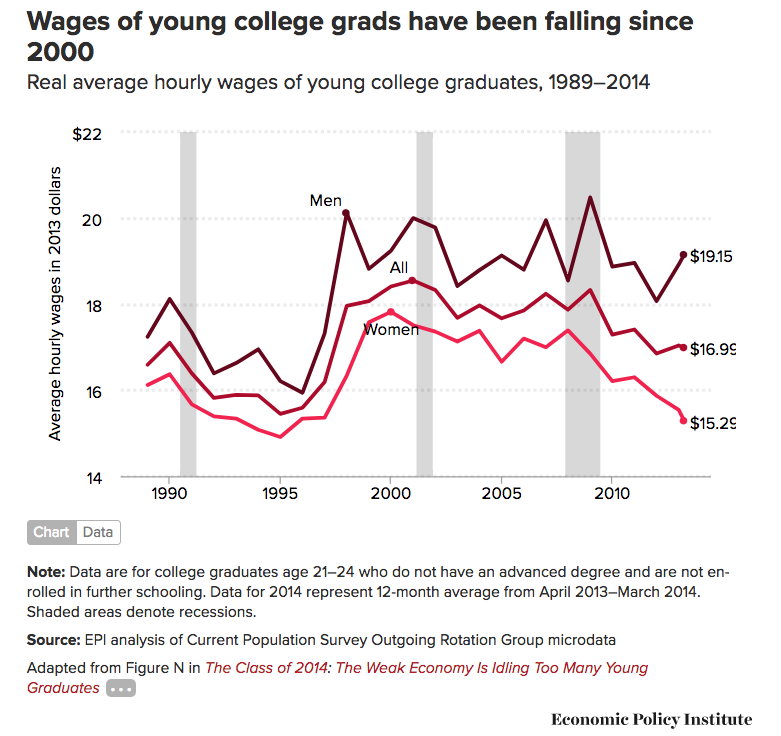Wash Post on Immigration: Celebrate Demographic Change, Ignore Economic Impact
The Washington Post‘s editors posted a long article February 6 which supposedly showed how President Donald Trump’s immigration reforms would change the nation’s racial demographics — but it completely ignored immigration’s economic impact on Americans.
The editors’ decision to follow the racial numbers is a repudiation of the journalistic slogan popularized after the Washington Post‘s Watergate stories: “Follow the money.”
The article said:
President Trump’s proposal to cut legal immigration rates would delay the date that white Americans become a minority of the population by as few as one or as many as five additional years, according to an analysis by The Washington Post …
The Census Bureau projects that minority groups will outnumber non-Hispanic whites in the United States in 2044. The Post’s analysis projects that, were Trump’s plan to be carried out, the date would be between 2045 and 2049, depending on how parts of it are implemented.
The reality of the United States’ non-racist, pro-assimilation civic life was buried in the 32nd paragraph:
One of the biggest unknowns is how long new immigrants will identify as racial minorities.
Simultaneously, the Washington Post ignores the huge impact of mass-immigration on Americans’ productivity and per-capita income. Both were entirely absent from the article — even though they are critical to the 320 million Americans who are deeply impacted by the government’s use of cheap-labor immigration as a tool to nudge up economic growth and government revenues.
The 1 million immigrants who are imported each year help investors by serving as both cheap workers and as taxpayer-supported consumers. Those investors include Jeff Bezos, the owner of the Washington Post and of Amazon.com.
But those immigrants also pressure down Americans’ wages and reduce — but not eliminate — the incentive for companies to invest in productivity-boosting labor-saving devices. The result is that the nation’s productivity slowed sharply after the 1965 immigration-expansion act, allowing a huge productivity minus compensation “wage gap” to deliver massive additional revenues to wealthy investors.
Instead of grappling with Trump’s proposed reform of the federal growth-by-immigration economic strategy, the Washington Post‘s article simply assumed that a smaller population ensures a smaller economy. It declared:
By reducing the country’s overall population, the plan could eventually reduce the overall growth rate of the U.S. economy. Under Trump’s plan, the U.S. economy could be more than $1 trillion smaller than it would have been two decades from now. That’s largely because the economy would have fewer workers.
The simple argument that Population = Economic Size is wrong. For example, the size of Ireland’s and South Africa’s economies are similar, even though Ireland’s non-diverse population is only one-twelfth of South Africa’s diverse population — 4.8 million vs. 57 million.
That Washington Post’s simple argument also focuses on the interests of people in government who gain as government grows in wealth and scale. In contrast, most American voters put a much higher priority on their per-person and per-family income — which depends on their machinery-aided productivity and on whether the labor market is swamped with immigrants. That priority helped elect New York real-estate developer Donald Trump to the White House in November 2016.
Companies want more imported workers because the nation’s formal unemployment rate is low. Without a reserve army of unemployed people, companies are forced to compete for new workers by offering higher wages, bonuses and training opportunities. For example, a new chart shows that annual wage growth (including inflation) rises above 2 percent once the “prime age non-employment rate” drops below 23 percent.
I continue to believe this, by @ModeledBehavior, to be the best macro chart out there right now. pic.twitter.com/TyM7nKl0Uk
— Henry Curr (@Henry_Curr) February 2, 2018
Immigration also redistributes wealth towards older urban elites by providing them with a huge army of cheap service-workers and by boosting their property values. In contrast, the class of young people, especially those without a university education or a foothold in major cities, lose economic opportunities to the huge inflow of cheap imported blue-collar and white-collar workers.
The Post also ignores the Democrats’ political support for the 1965 immigration act which imports more Democratic-leaning voters, and it treats nation’s huge demographic changes as a natural and unavoidable shift. This post-1965 political priority was cited by liberal writer John Judis on February 1 in the left-wing site, The American Prospect:
There is … [a] political dimension to the argument about immigration that is voiced by leading Democrats and Republicans. It is that continuing large-scale immigration of unskilled workers will help the Democrats politically and hurt the Republicans. That calculation lies at the bottom of Democratic hopes and Republican fears of immigration.
This Washington Post‘s assumption that the pro-Democratic 1965 policy change is unchangeable was made via a quote from an immigration advocate, Michael Clemons. He referred to the 1923 and 1924 immigration cutbacks, but not to the 1965 immigration expansion, saying:
“By greatly slashing the number of Hispanic and black African immigrants entering America, this proposal would reshape the future United States. Decades ahead, many fewer of us would be nonwhite or have nonwhite people in our families,” said Michael Clemens, an economist at the Center for Global Development, a think tank that has been critical of the proposal. “Selectively blocking immigrant groups changes who America is. This is the biggest attempt in a century to do that.”
Four million Americans turn 18 each year and begin looking for good jobs in the free market.
But the federal government inflates the supply of new labor by annually accepting roughly 1 million new legal immigrants, by providing work-permits to roughly 3 million resident foreigners, and by doing little to block the employment of roughly 8 million illegal immigrants.
The Washington-imposed economic policy of economic growth via mass-immigration floods the market with foreign labor, spikes profits and Wall Street values by cutting salaries for manual and skilled labor offered by blue-collar and white-collar employees. It also drives up real estate prices, widens wealth-gaps, reduces high-tech investment, increases state and local tax burdens, hurts kids’ schools and college education, pushes Americans away from high-tech careers, and sidelines at least 5 million marginalized Americans and their families, including many who are now struggling with opioid addictions.








Comments are closed.